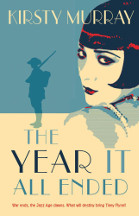The year it all ended by Kirsty Murray

Allen & Unwin, 2014. ISBN 9781743319413
(Age: 12+) Highly recommended. World War One, Spanish Flu, Returning
soldiers, Adelaide. The day Tiney Flynn tuns seventeen, bells ring
out over Adelaide to announce the end of World War One. Tiney and
her sisters go into the city to join the celebrations, and there
follows a six month hiatus as the world leaders negotiate peace.
Soldiers are returning home, some damaged and many changed, Tiney's
sister, Nette, marries a soldier who takes up soldier settler farm
at Cobdogla in the Murraylands, Thea goes to Art School, while Tiney
and Minna help prepare for a masked ball to celebrate peace. But the
family is still subjected to prejudice because of their German
heritage. During the day Tiney works at the Cheer-Up hut, where
soldiers can find some companionship but Tiney begins to find this
cheerless, as the long peace negotiations drag out. They are
devastated when they learn that their son and brother, Louis has
been killed in France within weeks of Armistace. Her father hides in
his study putting together a scrapbook of their brother's life and
Tiney has the idea that the family should somehow go to Europe to
find their brother's grave bringing them some relief from their
overwhelming grief.
In the background we see the girls coping with a changed world.
Tiney's world becomes smaller as her sisters leave home, and is
ecstatic when her aunt and uncle give her the money to accompany
friends of the family in their search for their dead son's grave.
Her dream has been realised.
The reality of war hits hard as she walks across battlefields with
bodies being exhumed for reburial, discovers mass graves, bombed
villages and people like her searching for their war dead.
This is a wonderfully astute look at the changing fortunes of young
women at the end of the war, a time of change for them as well as
society as a whole.
The story of Tiney and her sisters reflects many of these changes as
Nette marries someone she really does not know, Minna escapes to
Melbourne, to avoid the unwanted overtures of a returned soldier,
and Thea goes to art school, where her friend, Seb commits suicide.
The determination of Tiney in bringing some sense to her family
after their momentous loss, holds them together in a time of
desperate need. And at the same time, Tiney develops as a person,
going from a naive seventeen year old to a more politically aware,
confident and assured young woman ready for the new world.
Amongst the many books about Australia's involvement in war, this is
a standout. Not only a good story about one girl's development, but
a harrowing look at the family at home, desperate for news about
their son at war, while the thread of their German heritage, reminds
the readers that Australia is a land of immigrants, with some
treated in a manner which does us no credit.
A wonderful stand alone, this book could also be used in a
literature circle, in which a number of books with war as their
theme are presented to a class. Secondary students will find Tiney's
story engrossing, and along the way learn a lot about war and its
impact on those at home. Murray has skillfully incorporated
historical detail into the story, making this a luminous addition to
the genre of historical fiction.
Fran Knight